Technological innovation is already starting to reshape the retail landscape. Digital signage, electronic shelf tags, mobile shopping, digital payment, and a number of other emerging technologies are challenging traditional ways retailers have been doing business. While these technologies are clearly having an impact, there are 3 technologies on the horizon that are likely to provide massive disruption within the retail industry.
The first technology in retail that has been hyped quite a bit over the last few years is 3D printing. 3D printing is still in its infancy, but the potential for digital manufacturing is virtually limitless. Within the foreseeable future, we will be able to 3D print almost anything– from food to cars to houses and even body organs. The implications for retailers and their supply chains are very significant. No longer will retailers be limited to a fix product set with seasonal rotations. In the future, the product mix will be much more fluid and dynamic, and the amount of customization and personalization will be almost beyond what we can imagine. Today we can 3D print in full color in over 300 different materials, including mixed materials that combine metals, plastics, concrete and rubbers.
Not only will retailers need to take a completely new approach to the merchandise they offer and how they offer it, but 3D printing will have a dramatic impact on their physical plants. For example, in the next few years retailers will think nothing of 3D printing a pop-up store that can be erected in a strategic location for the holidays. Last year a Chinese company 3D-printed 10 full-sized houses in a single day at a cost of less than $5000 per house. Another Chinese company just 3D-printed an entire 200 square meter home and then assembled it in just 3 hours. The home included a spacious living room, a bedroom, a completely functional kitchen, and a large upstairs balcony. The entire printing and building process took only 10 days, and the building materials were sourced from industrial and agricultural waste. The printed modules are fire and water proof and are built to withstand high-magnitude earthquakes.

A second technology that will fundamentally transform the retail industry is robotics. Robots will first begin to invade the stock rooms of retailers and will soon play a critical role in shipping and receiving, inventory management, and related stock room functions. As substantial minimum wage increases take hold over the next few years and overtime laws make labor more expensive for retailers, robotics and automated technologies will begin replacing human workers. It won’t be long before robots will replace sales clerks on the store floor, and in the not too distant future entire stores will be run by robots. Just last month the first-ever robot-run hotel opened in Japan. The Henn-na Hotel is completely staffed by robots, including a robot receptionist, a robotic porter which guests program with their room number to have their bags delivered, and a concierge robot in every room to manage the lights, clock, and room temperature. Instead of using keys, guests gain access to their rooms through the use of facial recognition. Rooms at the Henn-na Hotel are very reasonably priced at $60 to $153 per night.

The third transformational technology is drone technology. This technology has also received a lot of media attention, particularly with some of the coverage on Amazon’s investments in drone delivery services. Although there are still a number or technical and political hurdles to be cleared, drone technology is progressing quickly and the applications for retail are quite significant both in terms of supply chain logistics but also in terms of customer service and delivery. Today we can purchase a product online and receive it next day via free shipping. What a lot of people don’t realize is that there is really no such thing as “free shipping.” The cost of free shipping either has to be built into the price of the product or absorbed in the margins of the retailer. However, with drone technology in retail, the economics of free shipping will change dramatically and next day service will be replaced by same day service or service within a few hours. Drones are being used today in the field of emergency medical response to save the lives of cardiac arrest victims. One group is using a network of drones, each of which can travel over 100 km/hr, enabling the drone to get to its destination in less than a minute. The drone’s integrated defibrillator, built-in emergency supplies and audio speaker let trained personnel walk callers through the defibrillator setup.

Each of these 3 retail technology trends have the potential to significantly disrupt the industry. Winning retailers will look for early opportunities to apply these technologies and adapt their business models accordingly.
Jim Hollen is the owner and President of RICH LTD. (www.richltd.com), a 35+ year-old California-based point-of-purchase display, retail store fixture, and merchandising solutions firm which has been named among the Top 50 U.S. POP display companies for 9 consecutive years. A former management consultant with McKinsey & Co. and graduate of Stanford Business School, Jim Hollen has served more than 3000 brands and retailers over more than 20 years and has authored nearly 500 blogs and e-Books on a wide range of topics related to POP displays, store fixtures, and retail merchandising.
Jim has been to China more than 50 times and has worked directly with more than 30 factories in Asia across a broad range of material categories, including metal, wood, acrylic, injection molded and vacuum formed plastic, corrugated, glass, LED lighting, digital media player, and more. Jim Hollen also oversees RICH LTD.’s domestic manufacturing operation and has experience manufacturing, sourcing, and importing from numerous Asian countries as well as Vietnam and Mexico.
His experience working with brands and retailers spans more than 25 industries such as food and beverage, apparel, consumer electronics, cosmetics/beauty, sporting goods, automotive, pet, gifts and souvenirs, toys, wine and spirits, home improvement, jewelry, eyewear, footwear, consumer products, mass market retail, specialty retail, convenience stores, and numerous other product/retailer categories.

